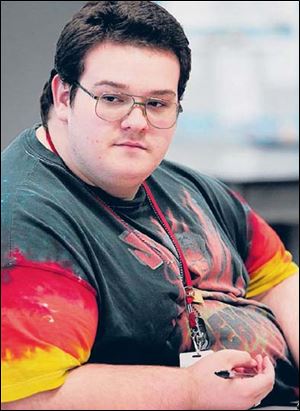
No kidding around: Fatty liver disease confronts obese youths
4/16/2012
Jake Watters is in the early stages of liverbrosis and has enrolled in treatment.
ST. LOUIS — Jake Watters is a typical teenager who loves listening to music, playing video games, and annoying his parents. But he also faces a health challenge that used to only be seen in much older people.
Fatty liver disease, a condition historically diagnosed in adults with diabetes or alcoholism, is increasingly diagnosed in obese children and teens.
About 6 million young people in the United States have the chronic condition that can lead to liver scarring, inflammation, and failure. Nearly all of them are overweight.
Doctors believe that the rise in fatty liver disease to about 17 percent of children mirrors the increase in childhood obesity, which affects nearly the same percentage.
Dr. Ajay Jain, a St. Louis University pediatrician, is recruiting patients for two pediatric fatty liver disease studies at the medical school. Children can turn the disease around in its early stages, he said.
“It is generally thought that if you do consistent lifestyle changes, the [fatty liver disease] is reversible,” Dr. Jain said.
The liver helps the body digest food, fight infections, and filter toxins in the blood. Once fibrosis, or scarring, develops the damage can lead to cirrhosis, liver failure, and cancer and also raises a patient’s risk of heart disease and death. In severe cases, liver transplant becomes the only treatment option.
Doctors usually find out a patient has fatty liver disease when they complain of pain, fatigue, or in serious cases, jaundice. Blood work also can indicate some problems with liver function in patients with no symptoms. An ultrasound can show fat deposits on the liver and a biopsy can confirm any scarring or cirrhosis.
Jake, who lives in Alton, Mo., is enrolled in a study at SLU to understand how the disease progresses in young people and how lifestyle changes might improve their condition. He’s started eating healthier, reading food labels and avoiding ingredients that rhyme with “gross” — sucrose, fructose, dextrose — that indicate sugar content. His mom packs a healthy lunch each day instead of the nachos, fries, and pasta he could buy at school.
Jake’s goal is to avoid the stomach reduction surgery that both his parents received. He also hopes to beat his predisposition to diabetes, which runs in the family.
It won’t be easy for Jake, 16, whose allergies to grasses and tree pollen make it hard to exercise outdoors. He already has completed his three required semesters of physical education at Alton High School. And his heavy homework load — which includes advanced German and physics — plus computer club and scholar bowl extracurriculars take up most of his free time.
Jake’s mom, Linda Watters, said she understands what’s at stake.
“I don’t want to lose my child before he’s had a chance to live,” she said.
Jake was born about a month premature and weighed 6 pounds, 4 ounces. He is the Watters’ miracle baby, born when Linda was 40 after years of miscarriages and failed pregnancy attempts.
The two studies enrolling patients at SLU include the lifestyle research Jake is involved in, plus a study of a drug to treat the most severe forms of nonalcoholic fatty liver disease.
Researchers will be watching about 160 kids ages 8 to 17 nationwide who have fatty liver disease to see if the drug cysteamine from California-based Raptor Pharmaceutical improves inflammation or scarring of the liver over time.
The trial taking place at 10 centers across the country including SLU is expected to cost about $15 million, paid for by Raptor and the National Institutes of Health.
The participants will take the drug or a placebo twice a day for one year. A small preliminary study showed some early results in reducing the toxins that can damage children’s livers.
“The general hypothesis is there’s going to be an improvement,” Dr. Jain said. “The question which is being asked, is to what degree it would happen, and whether it is going to be sustained after stopping the medicine.”
Jake, who stands 5-foot-11, weighed 464 pounds at his last monthly weigh-in and said he is starting to see positive results. The leather jacket that he couldn’t zip up at Christmas can now be zipped.
Jake is going public with his weight loss efforts because he wants to help and inspire other kids. He also wants people to look past the weight and see his smarts and personality, to know he has a 4.2 grade point average, he can name any song on the radio and play it on the guitar, he’s an expert in Norse mythology, and he’s already looking forward to law school.
“I’ve seen people tend to think that overweight people aren’t the smartest,” Jake said. “Don’t generalize. Don’t judge a kid by their size.”